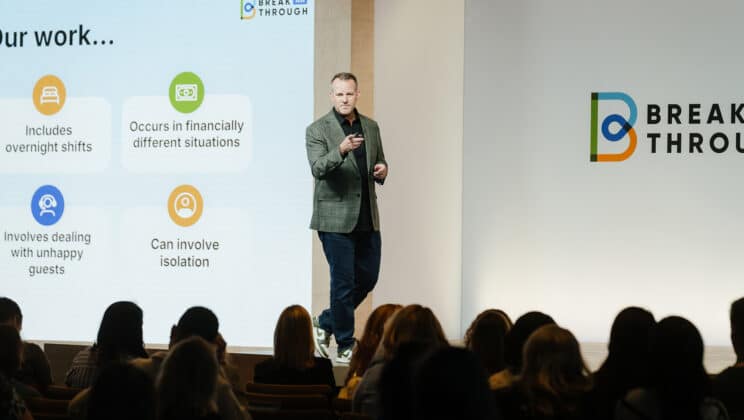2022 Workforce Mental Health Trends Forecast
December 14, 2021
Going into 2022, companies are increasingly taking action to attract and retain top talent by focusing on employees’ well-being—including meaningful support for their mental health. And more and more companies are not only responding to the heightened demand but also seizing this transformational shift in the workplace to reimagine workforce mental health.
What strategies will leading businesses use to address mental health at work in the year ahead? Here are our top 2022 mental health trends predictions, based on insights from Lyra clinicians, third-party experts, and our recent surveys of employees and employee benefits leaders across the U.S. For more insights, download the full 2022 mental health trends report.
1. Employer-provided mental health support will continue to rise to meet soaring demand
As workers’ mental health challenges have become ever more apparent during the pandemic, so too have their expectations of mental support from their employers. This is not lost on HR professionals: 60 percent of the 250 employee benefits leaders in Lyra’s latest survey said employee expectations around mental health support rose over the past year, and the vast majority (92 percent) said providing mental health support became a higher priority for their company over the past year.
In a tightening labor market, what was once seen as a nice-to-have or elite perk—not unlike fertility benefits or pet bereavement leave—will become more standard in 2022, especially in highly competitive industries such as financial services and health care. “Employees are getting more savvy about [mental health benefits], and it’s an employees’ market now,” said Joe Grasso, senior director of workforce mental health at Lyra. “Employers are forced to listen to those demands in a way they haven’t before.”
2. Flexible work policies that benefit mental health will become a mainstay
In 2022, we expect companies to give employees expanded options and control over how they work, with the aim of boosting workforce morale, engagement, and retention. Over the past two years, both employers and employees got a crash course on the importance of flexible work.
While the worst of these upheavals may be behind us, people now value flexible work more than ever—in fact, 69 percent of employees in our latest survey said flexible work policies such as remote work and work-from-home days are “very important” to them. Employees ranked flexible work second in importance among a list of key benefits only after “health, dental, and vision benefits.”
Many employers are also finding that the advantages of flexible work—fewer physical workspace-related costs, better employee morale, lower turnover, and greater productivity—outweigh the disadvantages. “Organizations are learning that optimum productivity can be achieved through increased flexibility about the location and timing of work,” said Vishwanath Baba, PhD, a professor of management at McMaster University. “In addition, the pool of skilled knowledge workers that [organizations] can have access to has become much larger.”
3. More attention to the mental health needs of kids and families
Over the past year and a half, employers have witnessed COVID-19’s mental health fallout not only for workers but also their children and families. While nearly one in five children had a mental health condition pre-pandemic, that number appears to have risen. Six in 10 parents in an October 2020 survey said their child had experienced emotional or mental health challenges in the past month, and a third reported that their child’s mental health had declined during the pandemic.
Meanwhile, access to the care kids need remains scarce: According to the Centers for Disease Control and Prevention (CDC), “Only about 20 percent of children with mental, emotional, or behavioral disorders receive care from a specialized mental health care provider.” These unmet mental health needs take a significant toll on working parents.
Given the need to retain working parents who might otherwise leave their jobs, in 2022 we expect to see employers offer more resources to support the mental health of employees’ kids and spouses as part of a holistic approach to workforce well-being. “There’s more recognition that it’s necessary for employers to provide care for the entire family and not just the employee, and as a result, employers are more interested in access to child care providers and family therapy,” said Grasso.
4. A greater focus on destigmatizing serious or complex mental health conditions
As the prevalence and severity of mental health challenges have soared since the pandemic began, so too has the need to combat stigma against serious mental illness in the workforce. Mental health-related stigma is a common barrier to care, and going without treatment can mean even bigger repercussions for employees dealing with serious conditions such as bipolar disorder, schizophrenia, or severe depression.
To combat this, we anticipate that employers in 2022 will amplify support and resources for workers grappling with more acute mental health needs, including the increasingly common challenges of substance use disorders and suicidal thoughts. In our recent survey of employee benefits professionals, nearly a third (28 percent) said they believe “more employees will seek support for complex issues, such as suicidality, or substance use disorder,” over the next year.
5. More mental health literacy and education
With an increasingly distributed workforce and the aforementioned rise in serious mental illnesses, people leaders need to be more vigilant for signs that an employee is in distress. To equip managers with the skills to do this, we expect more companies to offer mental health-related training and development opportunities to their workforces in 2022.
That will likely include “making mental health literacy more of a priority in employees’ learning and development, and things like mental health first aid,” said Grasso. Other key topics may cover building resilience in the face of unexpected challenges and strategies to create psychological safety among teams.
6. A shift toward building workplace structures that prevent burnout
More than one in three (32 percent) employees in our recent survey say they have experienced burnout over the past year, and 22 percent of employee benefits leaders surveyed recognize burnout as an issue affecting their company’s workforce. It’s also a catalyst in the “Great Resignation”: 40 percent of those who quit their jobs in 2021 cited burnout as a top reason for leaving, according to a survey of 1,000 full-time workers by employee experience firm Limeade.
As employers navigate how best to stem the tide of resignations and attract new workers, we predict that more companies in 2022 will take proactive steps to tackle organizational shortfalls that contribute to burnout. “We’re starting to see a shift where more employers are recognizing that burnout is a systemic issue, not an individual one,” said Grasso. “That means the solutions shouldn’t be individually focused.”
To learn more about 2022 mental health trends, download the full report.
CONTACT US
If you want help connecting with a coach or therapist, Lyra can assist you. You can get started today if Lyra is offered by your employer. Sign up now.
For employers who want to learn more about the value and impact of a mental health benefit, download our white paper or get in touch.
And check in frequently here or follow us on Facebook, LinkedIn, and Twitter for more insights into supporting employees’ mental health.
Explore additional blogs

Mental health tips
Beyond the One-Size-Fits-All Perks: Making Employee Mental Health Mission-Critical

Mental health at work
How to Spark Intrinsic Motivation on Your Team

Mental health at work